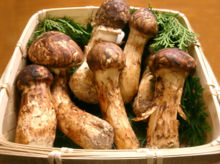Matsutake: Difference between revisions
→External links: adding interwiki id: |
|||
| Line 64: | Line 64: | ||
[[fr:Matsutake]] |
[[fr:Matsutake]] |
||
[[ko:송이]] |
[[ko:송이]] |
||
[[id:Matsutake]] |
|||
[[ja:マツタケ]] |
[[ja:マツタケ]] |
||
[[pl:Matsutake]] |
[[pl:Matsutake]] |
||
Revision as of 08:29, 12 October 2009
- Disambiguation: For the fictional character see Matsutake Kaoru.
| Matsutake | |
|---|---|

| |
| Matsutake | |
| Scientific classification | |
| Kingdom: | |
| Division: | |
| Class: | |
| Order: | |
| Family: | |
| Genus: | |
| Binomial name | |
| Tricholoma matsutake | |
| Tricholoma matsutake | |
|---|---|
| Gills on hymenium | |
| Cap is convex | |
| Hymenium is adnexed | |
| Stipe has a ring | |
| Spore print is white | |
| Ecology is mycorrhizal | |
| Edibility is choice | |
Matsutake (Japanese: 松茸, pine mushroom, Tricholoma matsutake = syn. T. nauseosum) or, shortly, Mattake is the common name for a highly sought after mycorrhizal mushroom known to grow in China, Japan, Korea, Finland and other places around the world. It is an important element of Japanese cuisine. The tradition of mushroom giving persists today in Japan's corporate world, and a gift of matsutake is considered special and is cherished by those who receive it.[citation needed]. In Vietnam, it is called nấm tùng nhung.
Distribution and habitat
Matsutake grow under trees and are usually concealed under fallen leaves and/or the duff layer. It forms a symbiotic relationship with the roots of a limited number of tree species. In Japan it is most commonly associated with Japanese Red Pine. However in the Pacific Northwest it is found in coniferous forests made up of one or more of the following: Douglas Fir, Noble Fir, Shasta Fir, Sugar Pine, Ponderosa Pine and Lodge Pole Pine. Further south, it is also associated with hardwoods, namely Tanoak and Madrone forests. The Pacific Northwest and other similar temperate regions along the Pacific Rim also hold great habitat producing these and other quality wild mushrooms.
In 1999, N. Bergius and E. Danell reported that Swedish (Tricholoma nauseosum) and Japanese matsutake (T. matsutake) are the same species.[1] The report aroused the import from Northern Europe to Japan because of the comparable flavor and taste.
Cost and availability

Matsutake are hard to harvest and therefore the price is very high. Domestic production of matsutake in Japan has been sharply reduced over the last 50 years due to a pine nematode Bursaphelenchus xylophilus, and it has influenced the price a great deal. The annual harvest of matsutake in Japan is now less than 1,000 tons, and it is largely made up by imports from China, Korea, the American Pacific Northwest (Northern California, Oregon, Washington, British Columbia), and Northern Europe (Sweden and Finland).[2] The price for matsutake in the Japanese market is highly dependent on quality, availability, and origin. The Japanese matsutake at the beginning of the season, which is the highest grade, can go up to $2,000 per kilogram. In contrast, the average value for imported matsutake is about $90 per kilogram.
Manjū
Manjū (饅頭), a kind of wagashi (traditional Japanese confections) are often formed into the shape of matsutakes, among other shapes.
See also
- Truffles: another highly sought-after fungus
- Himematsutake: the "princess matsutake"
References
- ^ Eric Danell, The Swedish matsutake and the Japanese matsutake are the same species!, The Edible Mycorrhizal Mushroom Research Group, Department of Forest Mycology and Pathology, Swedish University of Agricultural Sciences.
- ^ Template:Ja icon 輸入マツタケに異変 中国産激減、フィンランド参戦, J-CAST, 2007/9/26.
External links
- Pacific Rim Mushrooms - Matsutake Gohan
- Winema National Forest matsutake-information
- Hsiao-Ching Chou Fantastic Forage: Wild matsutake mushrooms Seattle Post-Intelligencer (2004.)
- Robert Sasata Tricholoma matsutake Healing-mushrooms.net
- James Benson Stir-fried wikipedia
- Template:Sv icon Pictures from Japanese matsutake-forests
